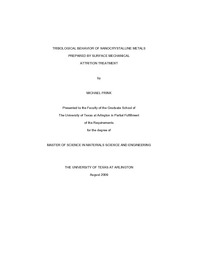
ATTENTION: The works hosted here are being migrated to a new repository that will consolidate resources, improve discoverability, and better show UTA's research impact on the global community. We will update authors as the migration progresses. Please see MavMatrix for more information.
Show simple item record
| dc.contributor.author | Frink, Michael | en_US |
| dc.date.accessioned | 2009-09-16T18:18:59Z | |
| dc.date.available | 2009-09-16T18:18:59Z | |
| dc.date.issued | 2009-09-16T18:18:59Z | |
| dc.date.submitted | January 2009 | en_US |
| dc.identifier.other | DISS-10288 | en_US |
| dc.identifier.uri | http://hdl.handle.net/10106/1722 | |
| dc.description.abstract | Nanocrystalline materials have shown great promise for a number of engineering applications ranging from structural and electronics to biomaterials and drug delivery. Nanoscale grain structures can cause tremendous improvements in strength, hardness and other mechanical properties. This is partially due to the suppression of dislocations within nanocrystalline grains and the entirely different deformation modes active at that scale. In spite of anticipated benefits, very little work has been performed to explore nanoscale effects on the tribological behavior of materials. Surface Mechanical Attrition Treatment (SMAT) is an effective and economical method to produce nanostructured surface layers in bulk materials. The process only takes hours to apply and industry is familiar with the similar process of shot peening. In the present work, SMAT was utilized to develop a gradient grain size nanocrystalline layer in pure nickel, aluminum, and titanium. The SMAT microstructures produced were characterized by surface profilometry, scanning electron microscopy in conjunction with energy-dispersive spectroscopy, x-ray diffraction, and nanoindentation. Pin-on-disk wear tests were performed on the SMAT processed materials to study the effect of the produced gradient microstructure on the tribological response with comparison to their microcrystalline counterparts. Wear testing showed that in general, the nanostructured layer reduces the coefficient of friction and improves the wear resistance but the extent of the improvements is material dependent. The largest reduction in friction was observed for pure Ni (~33%) followed by pure Ti (~14%). Minor effects on friction if any (< 1%) were observed for pure Al since its behavior was dominated by aluminum oxide formation at the asperity contacts. The SMAT treated Ni and Ti display friction characteristics similar to those of nanocrystalline materials possessing a uniform grain size. However, surface roughness resulting from the SMAT process may have contributed to somewhat initial higher wear rate. In both of the above cases, finer wear debris was produced for the SMAT processed metals suggesting a different wear mechanism compared to their microcrystalline counterparts. SMAT aluminum exhibited a minor reduction in friction compared to its microcrystalline counterpart and an earlier stage for aluminum oxide debris formation during wear. The faster aluminum oxide debris formation could be due to surface roughness effects, instead of the applied SMAT layer. The produced SMAT layer was not thick enough to have any appreciable effect. The present study shows that SMAT processing possesses good potential as a surface nanocrystallization/modification method to improve tribological response of certain engineering materials. | en_US |
| dc.description.sponsorship | Meletis, Efstathios | en_US |
| dc.language.iso | EN | en_US |
| dc.publisher | Materials Science & Engineering | en_US |
| dc.title | Tribological Behavior Of Nanocrystalline Metals Prepared By Surface Mechanical Attrition Treatment | en_US |
| dc.type | M.S. | en_US |
| dc.contributor.committeeChair | Meletis, Efstathios | en_US |
| dc.degree.department | Materials Science & Engineering | en_US |
| dc.degree.discipline | Materials Science & Engineering | en_US |
| dc.degree.grantor | University of Texas at Arlington | en_US |
| dc.degree.level | masters | en_US |
| dc.degree.name | M.S. | en_US |
| dc.identifier.externalLink | http://www.uta.edu/ra/real/editprofile.php?onlyview=1&pid=283 | |
| dc.identifier.externalLinkDescription | Link to Research Profiles | |
Files in this item
- Name:
- Frink_uta_2502M_10288.pdf
- Size:
- 6.412Mb
- Format:
- PDF
This item appears in the following Collection(s)
Show simple item record


